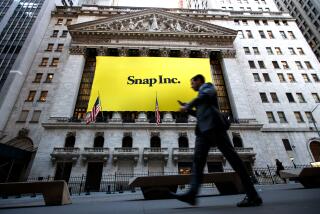Gap’s Sales Growth Streak Comes to End
- Share via
First Gagne, now Gap.
Gap Inc. said Thursday that its streak of 20 straight months of higher sales reports ended in June as weak receipts at its Gap and Old Navy stores offset gains at Banana Republic.
Although not as eye-popping as the end of Dodger reliever Eric Gagne’s 84-game consecutive saves streak, Gap’s results were a surprise to some analysts who figured the San Francisco apparel retailer would post another month of gains.
The company that operates 3,000 Gap, Old Navy and Banana Republic stores said sales at locations open at least a year -- a key measure of a retailer’s growth -- declined 2% last month, the first drop since September 2002. That was in contrast to an average 4.1% increase expected by Wall Street, according to research firm Thomson First Call
Gap’s total sales in June were flat at $1.5 billion.
“It was a disappointing month,” said Robert Buchanan, an analyst with A.G. Edwards & Sons, who was expecting the company to post a 6% same-store sales increase.
Wall Street viewed Gap’s poor showing in June as simply a stumble; its shares fell 33 cents to $23.15 on the New York Stock Exchange. Stocks of many other retailers also fell. Morgan Stanley’s retail index skidded 2.2% as shares of 33 of its 38 companies dropped.
By division, Gap’s so-called same-store sales fell 2% contrasted with an 8% gain a year earlier; sales at Old Navy dropped 2% contrasted with an increase of 11%; and sales at Banana Republic, the company’s highest-priced chain, rose 11% compared with a 7% rise a year earlier.
Company executives blamed the decline on lighter foot traffic at its stores and higher markdowns on clothing at Old Navy in particular. That chain’s customers on average bought more items, but they were at reduced prices. In addition, June is the month that the company’s three chains begin clearing out summer merchandise to make room for fall goods, which hit the shelves later this month.
Still, “overall June sales and margins were below expectations,” said Sabrina Simmons, senior vice president, treasury.
Analyst Jeffrey Klinefelter of Piper Jaffray & Co. had forecast a gain in the low to midrange single digits. But he acknowledged that the blip was “not completely unanticipated” because a number of retailers (although not Gap) had warned of weak sales even before the month was over.
“This doesn’t change my perspective on Gap’s recovery or its potential for growth going forward,” said Klinefelter, who rates Gap stock “outperform” and has a price target of $28 a share.
Until June, the trend at Gap was upbeat. Beginning in October 2002, Gap posted solid same-store sales gains each month, with the exception of two periods late last year, when the increase was only 1%. The streak followed a 29-month stretch of declines.
The streak also started about the same time that former Walt Disney Co. executive Paul Pressler was named Gap’s new chief executive, replacing longtime CEO Mickey Drexler, who has since moved to J. Crew. Pressler is widely credited with turning around Gap’s fortunes by hiring a new management team, slimming down inventories to keep markdowns to a minimum and offering fashions appealing to shoppers in their 20s and 30s.
Gap wasn’t the only major U.S. retailer to have a gloomy June. Merchants ranging from giant Wal-Mart Stores Inc. to apparel and housewares discounter Ross Stores Inc. reported disappointing sales.
Many blamed cooler weather in the Northeast for keeping people out of stores, which in June were stocked with summer fashions. The uptick in gasoline prices also appeared to curtail shopping excursions, particularly to discounters and mass merchants.
Wal-Mart, the world’s largest retailer, cited its customers’ higher gas costs as among the reasons for its June same-store sales rising just 2.2%, the smallest gain in longer than a year. Analysts surveyed by Thomson First Call were expecting a 3.6% increase. Wal-Mart shares fell 14 cents to $52.18 on the New York Stock Exchange on Thursday. The company forecast that July same-store sales would be up a modest 2% to 4%.
Newark, Calif.-based Ross said difficulties implementing a new merchandising system were behind its less-than-expected 1% sales gain. Ross shares fell $1.23 to $24.40 on Nasdaq.
Most of the nation’s big retail chains report their sales totals each month. Analysts and investors focus on the same-store or comparable-store number as the best gauge of growth; sales from new stores can make a company look as if it’s growing more than it actually is.
*
(BEGIN TEXT OF INFOBOX)
Mixed bag
June retail sales were disappointing as several discounters, department stores and apparel merchants fell short of expectations.
Percentage change from a year earlier in sales at stores open at least one year:
Company % change
Guess +12.7% Limited Brands +7.0 Pacific Sunwear +7.0 Nordstrom +5.7 J.C. Penney +4.8 Federated +3.4 Gottschalks +3.3 Wal-Mart +2.2 Target +2.2 May +1.9 Hot Topic -0.4 Gap -2.0 Sears -3.1 Ross -4.0 Wet Seal -10.1
Sources: Times wire services, company reports
More to Read
Inside the business of entertainment
The Wide Shot brings you news, analysis and insights on everything from streaming wars to production — and what it all means for the future.
You may occasionally receive promotional content from the Los Angeles Times.










